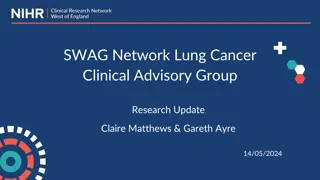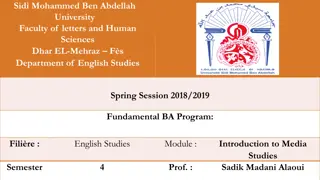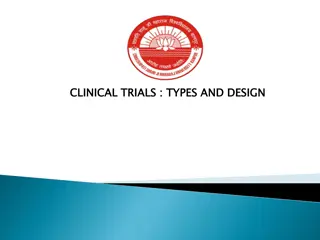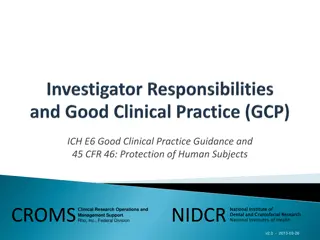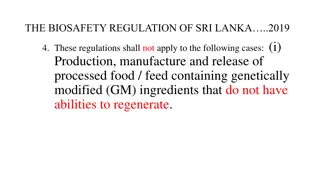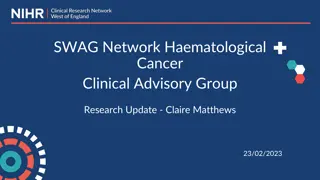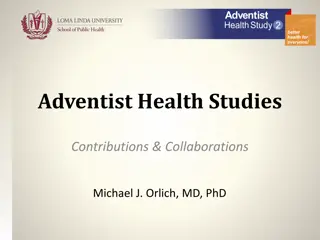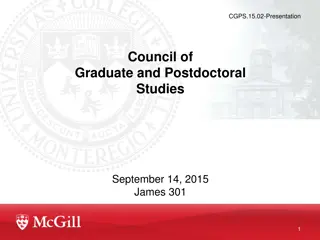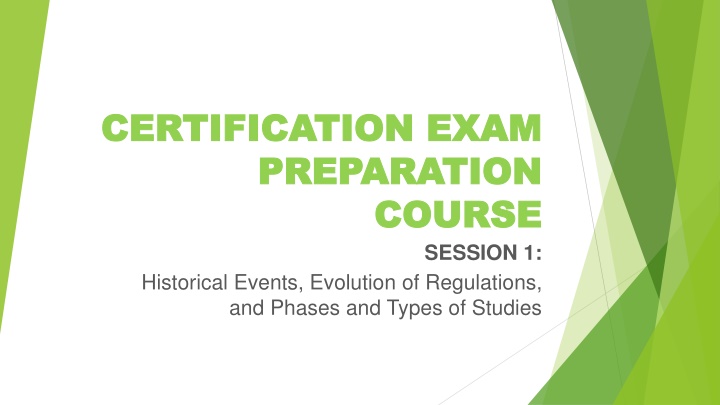
Evolution of Regulations in Research Studies
In this session, delve into the historical events, regulations, and phases of research studies. Explore significant milestones such as the founding of NIH, FDA regulations, Tuskegee Syphilis Study, Nuremberg Code, Belmont Report, and modern policy developments like HIPAA and ICH GCP E6. Gain insights into ethical principles, human subject protection, and responsible conduct of research. Enhance your understanding of the evolution of regulations governing research practices.
Download Presentation

Please find below an Image/Link to download the presentation.
The content on the website is provided AS IS for your information and personal use only. It may not be sold, licensed, or shared on other websites without obtaining consent from the author. If you encounter any issues during the download, it is possible that the publisher has removed the file from their server.
You are allowed to download the files provided on this website for personal or commercial use, subject to the condition that they are used lawfully. All files are the property of their respective owners.
The content on the website is provided AS IS for your information and personal use only. It may not be sold, licensed, or shared on other websites without obtaining consent from the author.
E N D
Presentation Transcript
CERTIFICATION EXAM CERTIFICATION EXAM PREPARATION PREPARATION COURSE COURSE SESSION 1: Historical Events, Evolution of Regulations, and Phases and Types of Studies
Part 1 of Session 1: Historical Events, Evolution of Regulations
Handouts: Timeline of Research Events Historical Events and the Resulting Regulation/Guidance Worksheet Matching Worksheet
Timeline 1887 NIH founded 1906 FDA Pure Food and Drug Act 1932-1972 The Tuskegee Syphilis Study 1937 Elixir Sulfanilamide Disaster 1938 Federal Food, Drug, and Cosmetic Act 1936-1945 Nazi Experiments 1946 Nuremberg Doctor s Trial 1947 The Nuremberg Code
1953 First US Federal Policy for Protection of Human Subjects 1962 Kefauver-Harris Drug Amendment 1964 World Medical Association, Helsinki Declaration 1974 Congress passes the National Research Act 1976 Medical Device Amendment 1979 The Belmont Report 1981 FDA Regulations Title 21
1989 Office of Scientific Integrity and the Office of Scientific Integrity Review 1989 Responsible Conduct of Research Training 1990 International Conference on Harmonization Guidelines 1990 The Safe Medical Devices Act 1991 The Common Rule 1992 Office of Scientific Integrity and the Office of Scientific Integrity Review 1993 MedWatch
1996 HIPAA 1996 The World Health Organization Guidelines for Good Clinical Practice 1999 The NIH and the OHRP required training 2004 Secretary s Advisory Committee on Human research Protection 2017 Revisions to Common Rule Revisions to ICH GCP E6
A system of moral principles that govern a person's behavior or how an activity is conducted Dealing with what is good and bad, and with moral duty and obligation Ethics The basic concepts and fundamental principles of decent human conduct Based on a person s own values Standards of right and wrong that recommend what humans should do, usually in terms of : rights, obligations, benefits to society, fairness, or specific virtues
Nuremberg Code Declaration of Helsinki Belmont Report
Nuremburg Code 1947 Qualified researchers must use appropriate research design Must have a favorable risk/ benefit ratio(minimization of risk) Informed consent is essential 10 ethical principles: Participants must have the ability to terminate their participation at any time https://history.nih.gov/display/ https://history.nih.gov/display/ history/Nuremberg+Code Voluntary participation
Have their roots in the Nuremburg Code GCP guidelines
The Declaration of Helsinki The well-being of the subject should take precedence over the interests of science and society Respect for persons and the welfare of animals Consent should be in writing Protection of the subjects, special protection for vulnerable populations Use caution if participant is in dependent relationship with researcher Limited use of placebo, especially if treatment is available Medical research is justified only if there is likelihood that the research populations stand to benefit from the results of the research Negative as well as positive results should be published or made publically available Greater access to benefit once research is concluded
Individuals should consent to participate in studies Protection for those who cannot give their consent, such as children, people with diminished abilities, and prisoners Belmont Report Participation in research should: prevent harm minimize risks maximize possible benefits. Fairness in procedures for selecting participants Ethical Principles and Guidelines for the Protection of Human Subjects of Research
Respect for persons Belmont Report Beneficence Justice
Choices of autonomous individuals should be respected People incapable of making their own choices should be protected Respect for Persons Voluntary subjects need adequate information for decision-making Respect for person during the ICP is provided when adequate standards for informed consent are satisfied: Information Comprehension voluntariness
Protect from harm Be aware of various potential harms Participation in research is associated with a favorable balance of potential benefits and harms Beneficence Maximize possible benefits, minimize potential harm We must treat persons in an ethical manner not only respecting their decisions and protecting them from harm, but also making efforts to secure their well-being
Fair and unbiased selection of subjects Equal treatment of people Participation in research is associated with a favorable balance of potential benefits and harms Justice May not exploit or exclude vulnerable individuals who may benefit without good reason Favorable distribution of burdens and benefits
Principles of Belmont Report Meaning Practice Each person has individual rights Obtain informed consent, protect privacy, maintain confidentiality Respect for Persons Provide benefit, protect from harm, limit risk Risk-benefit assessment made Beneficence Standard procedures used Equitable selection of subjects Includes all groups that may benefit but does not single out one group Justice
Part 2 of Session 1: Phases and Types of Studies
Handouts: Phases and Types of Studies/Graphics Phases of Clinical Trial Chart Blinding and Randomization Process of Drug Development Handouts
A clinical study involves research using human volunteers (also called participants/subjects) that is intended to add to medical knowledge What is a Clinical Study? There are two main types of clinical studies: interventional studies observational studies
Evaluates a medical, surgical, or behavioral intervention Primary way to discover if a new treatment/device is safe and effective in people Purpose To learn if a new treatment is more effective and/or has less harmful side effects than the standard treatment Find ways to prevent a health problem May also look at how to make life better for people living with a life-threatening disease or a chronic health problem
Categories of Clinical Trials INTERVENTIONAL OBSERVATIONAL
Test the safety and effectiveness of a candidate drug, therapy or experimental treatment Classifications: Treatment Research Interventional Clinical Trials Prevention Research Diagnostic Research Screening Research Quality of Life Research Genetic studies Epidemiological studies
Do not test drugs or treatments Researchers observe participants by monitoring their health over a period of time Observational Clinical Trials Provide researchers with data that advances our understanding of certain diseases and how to treat the disease Assess health outcomes in groups of participants Participants may receive interventions (which can include medical products such as drugs or devices) or procedures as part of their routine medical care
Types of Study Designs CASE-CONTROL STUDY CROSSOVER STUDY DOUBLE-BLIND CLINICAL TRIAL COHORT STUDY EXPERIMENTAL STUDY FEASIBILITY STUDY LONGITUDINAL STUDIES MULTICENTER CLINICAL TRIAL OBSERVATIONAL STUDY PROSPECTIVE STUDY RETROSPECTIVE STUDY PILOT STUDY UNICENTER/SINGL E SITE CLINICAL TRIAL SINGLE-BLIND CLINICAL TRIAL
Phases of Studies Phase 0 Phase 1 Phase2 Phase3 Phase 4
Arent widely used Studies are very small, often with fewer than 15 people Purpose is to help speed up and streamline the drug approval process Only a few small doses of a new drug in a few people, given for a short period of time Phase 0 Drug doses are low, there s also less risk to those in the trial Almost no chance the people in phase 0 trials will benefit, benefit will be for other people in the future Not a required part of testing a new drug
Usually, the first that involve people for a new drug Small group of often healthy people (20 to 80) Emphasis is on safety: assess side effects and to determine the best/highest/route for the drug Phase 1 Controlled, closely monitored trials Performed to determine the metabolism and pharmacologic actions of the drug in humans High risk to benefit ratio Phase 1 oncology trials are likely to enroll subjects who have failed standard therapy Placebos (inactive treatments) are not used in phase I trials
The emphasis is on effectiveness and side effects Purpose is to determine the right dosage and effectiveness in treating a particular disease/condition Enrolls hundreds of subjects and can last several years Determine the common short-term side effects and risks associate with the drug Phase 2 Focus is to determine if the intervention is more effective than standard alternatives Normally involves assigning participants to different treatment groups, where each group can receive different doses or delivery of the treatment Usually, there is a control group The health of the group(s) of patients who received the different types of treatment is compared to the control groups
Primarily focuses on determining whether the treatment would be safe and effective for a wide variety of people The number of subjects usually ranges from several hundred to about 3,000 people The plan normally involves assigning participants to treatment or control groups If the FDA agrees that the trial results are positive, it will approve the experimental drug or device Phase 3 Are often conducted in many places across the country (or even around the world) at the same time Placebos may be used in some phase III studies, but they re never used alone if there s a treatment available that works Sometimes, a patient who is randomly assigned to the placebo for part of the study will at some point be offered the standard treatment as well
After approval by the FDA and manufacturing of the drug for a long period of time in diverse populations May involve thousands of people To obtain further information about the risks, benefits, safety, and long-term effects, or to test the product in special patient populations Phase 4 Most likely to use a drug registry Detection of rare side effects and those associated with chronic/long-term use of the drug May also look at other aspects of the treatment, such as quality of life or cost effectiveness Sometimes, the side effects of a drug may not become clear until more people have taken it over a longer period of time.
Phase Population Study Design Focus Duration of treatment 1-15 people Aren t widely used Sub-therapeutic dose No safety or efficacy parameters Single/micro dose Drug is given for a short time 0 Usually 20-80 healthy people Normal volunteers Dose escalation to establish maximum tolerated dose Safety and tolerability to determine the metabolism and pharmacologic actions Short term, usually less than 30 days 1 200-300 volunteers with a targeted disease Well-controlled, strict inclusion/exclusion criteria, most rigid study design, comparison between placebo and active controls Comparison study, looking for effectiveness, efficacy, and safety (assess side effects) Short term, usually less than 1 year, but can last several years 2 Determine the correct dose and effectiveness in treating a particular disease Several Hundred to several thousand Eligibility is looser than Phase 2, multi-centered trials Safety and efficacy, risk/benefit analysis, safety profiles Parallel, anticipated treatment Could last for years Often conducted in many places at the same time 3 Investigational vs placebo All people on the treatment Usually no study Safety in large groups, patient satisfaction, additional safety data Ongoing after FDA approval 4
Clinical trials which usually involve an intervention such as medication, psychotherapy, new devices, or new approaches to surgery or radiation therapy is called __________. A. Diagnostic Research B. Treatment Research C. Screening Research D. Quality of Life Research
The Belmont Report was created as part of the _____________________. a. National Research Act of 1974 a. National Research Commission of 1974 a. National Research Act of 1977 a. National Research Commission of 1977
The Declaration of Helsinki was created by the a. World Health Organization b. World Medical Association c. World Health Association d. World medical Organization
Observational Clinical Trials: A. Provide researchers with data that advances our understanding of certain diseases and how to treat the disease B. Assess health outcomes in groups of participants C. Participants may receive interventions (which can include medical products such as drugs or devices) or procedures as part of their routine medical care D. A and B E. All of the above
In which order does the drug development process follow? A. Confirmation of drug efficacy and safety in humans, discovery of a new compound, approval and manufacturing, drug is marketed B. Discovery of a new compound, confirmation of drug efficacy and safety in humans, approval and manufacturing, drug is marketed C. Discovery of a new compound, approval and manufacturing, Confirmation of drug efficacy and safety in humans, drug is marketed
GCPs have their roots in the __________. A. Belmont Report B. Declaration of Helsinki C. Nuremburg Code D. ICH GCP E6 (R2)
The Declaration of Helsinki is the oldest ethical framework for researchers. True False
The influencer for the Belmont Report was the _______________. a. Nuremberg war crimes b. The Guatemala study c. The Tuskegee study d. The Willowbrook study
According to the Declaration of Helsinki, which of the following is not included when addressing the Informed Consent Process? a. Participation must be voluntary b. Refusal to participate should not affect the patient- physician relationship c. Consultation with others is necessary d. Information regarding payment for participation should be included



